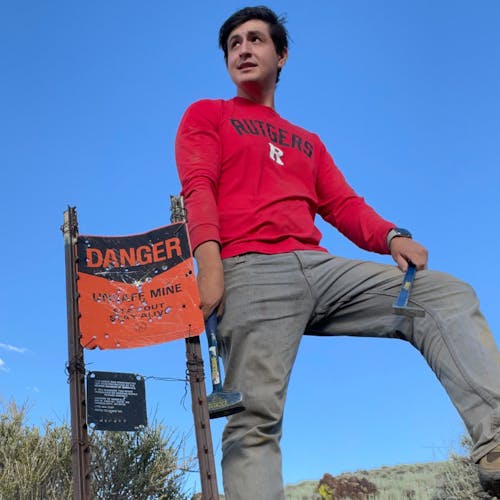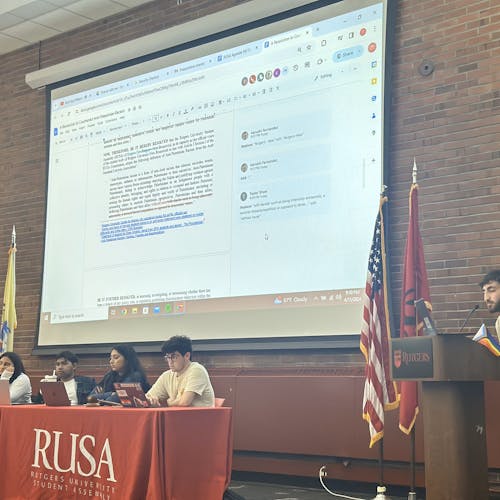Rutgers hosts "Marking Time: Prison Arts and Activism Conference"

Regina Austin and Ann Schwartzman
Regina Austin could not get a prisoner’s story heard because the Department of Corrections rejected her for possible security risk. This is one of the many adversities she faced as a documentarian.
Austin and Ann Schwartzman, executive director of the Pennsylvania Prison Society, shared their difficulties coordinating prisons with the press yesterday at the “Marking Time: Prison Arts and Activism Conference,” hosted by the Rutgers Institute for Research on Women.
The conference, running until Oct. 10, features panels, keynote speeches and film screenings examining the American prison system through art. This art, created by inmates and artist volunteers, have witnessed prison life through their community work.
The panel “Laws, News and Arts” took place at Jane Voorhees Zimmerli Art Museum on the College Avenue campus.
Austin, director of the Penn Program on Documentaries & the Law in the University of Pennsylvania Law School, focuses on the legal use of documentaries. She is working on using video as a supplement to written records in clemency petitions for prisoners.
Videos were useful, Austin said, because they could help illiterate prisoners or prisoners who needed translation services get a fair chance to seek pardon. One such example was a man incarcerated as a juvenile since 1956.
The Department of Corrections turned down Austin’s proposal for “security and community sensitivity,” referring to the security ramifications caused by the presence of cameras in prison facilities.
“The goal is to show the liability of visual legal advocacy and to seek ways to increase its legitimacy,” she said.
Schwartzman has been working extensively in criminal justice for more than 20 years.
“We have turned from a system of individuals — where you see people, where you see faces — to numbers,” Schwartzman said.
Starting with a film documentary from 1989 showing the inside of a Pennsylvania prison, Schwartzman noted the culture influence and changes in mass incarceration over time.
The documentary was filmed at the heyday of criminal justice, but it is no longer possible to have the same media presence in Pennsylvania.
More than two million people are incarcerated across the country, Schwartzman said.
The nearly $2 billion that Pennsylvania put into the state prison was mostly used to keep the facilities functioning. Arts and music programs were the first programs they cut back.
The inmates have brilliant art talent to offer, Schwartzman said.
“We need the system to open, not close … there is no other way for the public to see what is going on,” she said.
Jesse Krimes
When Jesse Krimes was an aspiring artist, he did not imagine he would be scraping hair gel, old prison playing cards and government-issued bed sheets on the dirt floor of his prison cell.
Krimes was arrested for the possession of 147 grams of powdered cocaine, accused for 50 kilograms (340 times as much) and sentenced for 500 grams.
He said his experience with the federal prison system is not an uncommon one, but he was lucky. The judge, taking into account his clean record and community ties, cut his sentence down from 100 months to 70, the largest variance he had ever given.
At the time of his arrest, Krimes was a college graduate with a bachelor’s degree in studio art and a soon-to-be father.
Although much of that life was abruptly cut off for the next half decade, he continued creating art in prison and documenting his “purgatory” experience. He discussed one of his pieces, “Apokaluptein: 16389067” as a part of the conference.
Krimes attributes his harsh sentence to his refusal to cooperate with the prosecution when they asked him to give names of other perpetrators.
“This was a decision I made, and I wanted to take responsibility,” he said.
The initial range for his sentence was 30 to 43 months, but once prosecutors obtained alleged statements against him from other accused individuals, which Krimes called hearsay, the accusations drastically increased and the potential sentence jumped from 10 years to life.
“They labeled me as a drug kingpin,” he said.
The judge recommended a close-to-home, low-security facility for Krimes, but he was instead sent to a medium-security facility in North Carolina, surrounded by violent gangs and mobs hundreds of miles from his Pennsylvania home.
“Apokaluptein” comes from the Greek roots for “apocalypse,” meaning, “to uncover or reveal.” The piece is a collection of images Krimes took from The New York Times, pressing them onto federal prison sheets using hair gel.
The sheets were torn and mailed home piece by piece, so Krimes never saw his full work displayed until he returned after five years.
The rest of the title, “16389067,” is Krimes’ former inmate number, which came to define him. He felt the agony of “Apokaluptein” in its second, more modern meaning — apocalypse in personal destruction.
“As soon as you’re in the system, you’re dehumanized,” he said.
Marisa Belausteguigoitia, professor at the National Autonomous University of Mexico, said art can be an illuminating mechanism, which improves prison life while voicing structural criticism of the system.
Krimes will be debuting an art exhibition in Philadelphia soon, said Nicole Fleetwood, associate professor in the Department of American Studies.
In the Dauphin County Prison of Pennsylvania, Krimes spent his days on dirt floors, locked down for 23 hours a day with one hour allotted for making phone calls and taking a shower.
He had no access to outside recreation, sunlight or fresh air.
“You’re stripped of identity, you’re stripped of dignity,” he said. “They take everything from you.”
Reginald Dwayne Betts
Reginald Dwayne Betts, an award-winning author and student at Yale Law School, was once known mostly for his criminal history.
But he took his eight years in prison and turned it into an opportunity to change his life with poetry, writing and social justice advocacy.
Betts, a poet and the author of “A Question of Freedom: A Memoir of Learning, Survival, and Coming of Age in Prison,” discussed his journey and read his poetry about prison and surviving an unjust system.
Betts, a promising student in his high school, went to prison at 16 years old for stealing a car. He was incredibly naive and thought he would face no consequences for his actions, as he thought he was better than the typical inmate.
“I had no expectation that I would be sent to prison,” he said.
Going into prison, he noticed that many of the inmates and workers were black. The disproportionate ratio of black to white inmates made him realize that many of the inmates were in the same situation as he was, which opened his eyes to the truth of the justice system.
He found himself wondering what he could do with that time to better himself down the road — writing was the answer to that question.
The prison workers would throw him books. One book of poetry that impacted Betts contained poems that explored the concept of survival, which made him realize art could be political.
In a super-maximum security prison, he had no idea how different prisons could be from one another. Betts also only recently learned how differently the public views the prison experience.
He said certain questions do not have to be answered as a community because there are certain issues that do not touch every member of the community equally.
“It is no way [to know] what it’s like to be in prison unless you are completely intimate … then you can make suggestions,” he said.
One of his cellmates had a 60-year sentence for attempted capital murder. He tried to contact the American Civil Liberties Union in 1996 about the man’s plight, but it only sent him back a form letter.
Those types of experiences made him go to law school because even writing poems was not sufficient to get the attention of the public to the injustices of the prison system.
He read a poem to the audience based on the story of a man who created a recording device out of two Walkman devices. The man turned the play button into a record button and the headphones into a microphone.
He related the story to the necessity for creativity in the discussion about the incarceration system.
“It made me excited about the possibilities,” he said.



